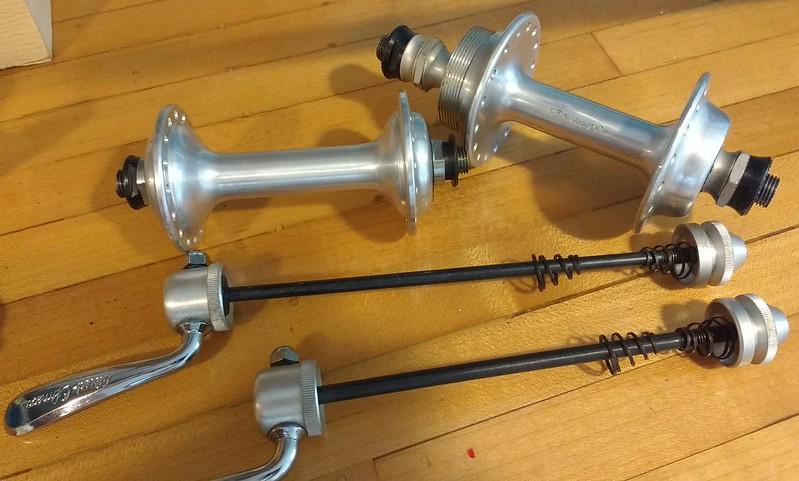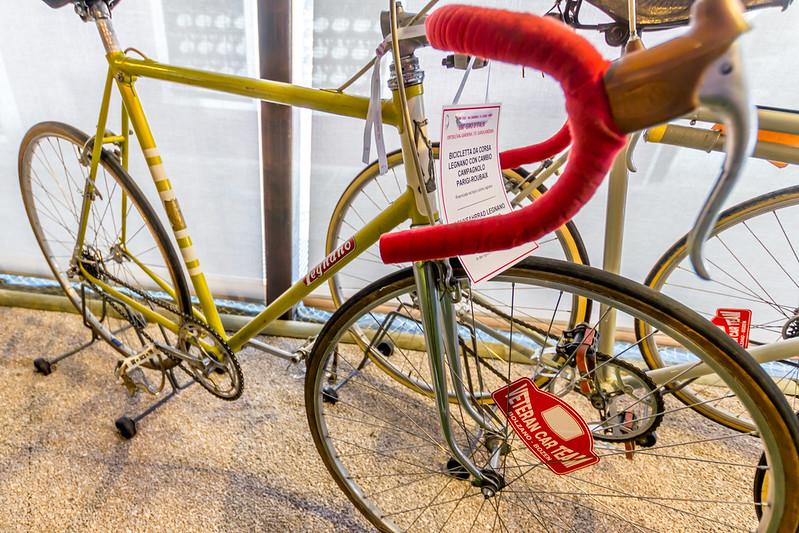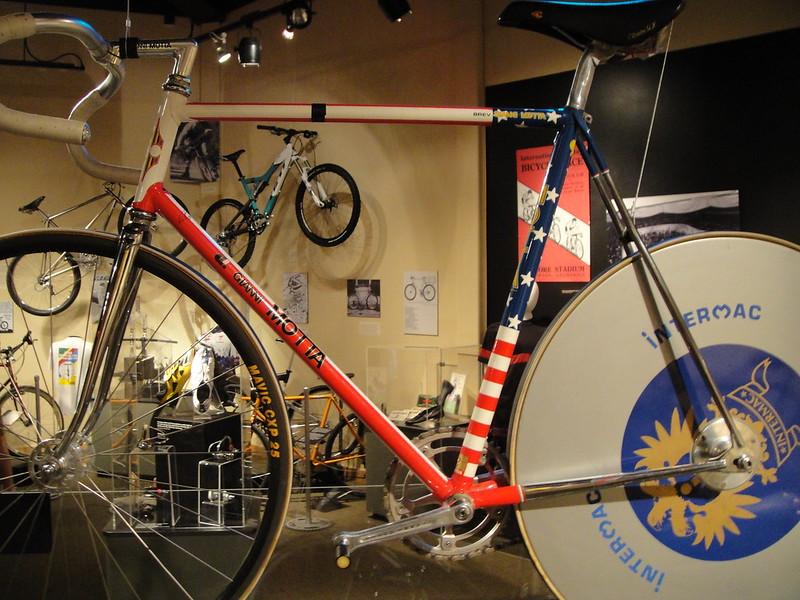- News
- Reviews
- Bikes
- Components
- Bar tape & grips
- Bottom brackets
- Brake & gear cables
- Brake & STI levers
- Brake pads & spares
- Brakes
- Cassettes & freewheels
- Chains
- Chainsets & chainrings
- Derailleurs - front
- Derailleurs - rear
- Forks
- Gear levers & shifters
- Groupsets
- Handlebars & extensions
- Headsets
- Hubs
- Inner tubes
- Pedals
- Quick releases & skewers
- Saddles
- Seatposts
- Stems
- Wheels
- Tyres
- Tubeless valves
- Accessories
- Accessories - misc
- Computer mounts
- Bags
- Bar ends
- Bike bags & cases
- Bottle cages
- Bottles
- Cameras
- Car racks
- Child seats
- Computers
- Glasses
- GPS units
- Helmets
- Lights - front
- Lights - rear
- Lights - sets
- Locks
- Mirrors
- Mudguards
- Racks
- Pumps & CO2 inflators
- Puncture kits
- Reflectives
- Smart watches
- Stands and racks
- Trailers
- Clothing
- Health, fitness and nutrition
- Tools and workshop
- Miscellaneous
- Buyers Guides
- Features
- Forum
- Recommends
- Podcast
feature
 Gianni Motta bike - by Anders on Flickr Creative Commons licenced under CC BY-ND 2
Gianni Motta bike - by Anders on Flickr Creative Commons licenced under CC BY-ND 2Five classic Italian cycling brands of the 70s and 80s
For many of us who grew up during 1970s and 80s, Italian bikes and components were the things or dreams and teenage lust. With cycling films like Breaking Away showing them off in all their glory, it’s hardly surprising.
Italian was simply sexy, or sex on wheels as you might say. There were many legendary Italian bike, component and clothing brands that were prominent during that era, and some still survive today. Some live on only in naming rights, while others just evaporated with the decline of the European bike industry that wreaked havoc at that time.
> How Cerchio Ghisallo make classic wooden bike wheels
Here are five legendary Italian brands of that era that are seemingly lost to the modern cycling world; although some, obviously, have a much longer and deeper history to them...
Galli
All gloriously gold, drilled to perfection, a little sloppy at actually stopping you... but while those Galli Criterium brakes took a teenage me some time to work off, they were my pride and joy during the early 80s, as were my matching gold and bendy, super light golden Galli toes clips. Ahh, early Italian bling of the finest order! I guess that those curvaceous good looks and that undefinable sense of style that came from the Italian brand should come as no surprise, given that the head of the company during that era was none other than legendary team manager Gianni Savio, the grandson and heir to Giovanni Galli, the man who founded the company during the late 1930s.
The component order of the day back then was dominated by Campagnolo, much as it had been for many years, and yet in terms of pizzazz Galli was the young sequin strutting upstart. Even though they had actually been around for decades, it was Savio who added his flare to the products during this period of time. They may not have quite matched their Italian piers in performance and durability terms, but they certainly made an impact on many young riders during the 70s and 80s, and came with that flashy image that brightened up a traditionally tweed-like era when it came to bike componentry.
Galli sponsored a number of pro teams over the years, but unfortunately the emerging and big budget dominance of the major players – such as Shimano, and the fading but ongoing reign of Campagnolo, slowly drained their marketplace dry, forcing the doors on their Turin HQ to close during the late 1980s. Gone, but certainly not forgotten by those of a certain age.
> 10 of Shimano and Campagnolo's worst ideas
Ofmega
During the late 70s, and even more so through the 80s, it was hard to miss Ofmega components. They were not only innovative and mostly of good quality, but they often came in snazzy anodised colours. Their highly innovative Mistral groupset even came in pink, blue and yellow, and with plastic parts. This was unheard of at the time.
> Cycling trends and traditions that are gone but not forgotten
The tale of Ofmega is somewhat blurry, although it's widely acknowledged that the company was founded in late 1960s by brothers Mario and Dino Perotti. Some of their early components were made for bike brands such as Legnano, Colnago and Bianchi. It was during the mid 1970s that their groupsets started making their presence felt in the market, and later Ofmega also sponsored pro teams such as Atala-Ofmega, which included a young Gianni Bugno.
It's rumoured that Ofmega merged with Simplex in 1987, although that has seemingly never been confirmed. By the mid-2000s, the brand had disappeared into the mist that shrouded its colourful history. There are still many Ofmega cranks and parts to be found on eBay should you fancy a bold ride down memory lane.
Regina
This was probably the most popular freewheel back in the day - Regina ORO. This arrived this morning and is NOS with 13-21 tooth sprockets. pic.twitter.com/xBupq5dq5W
— The Campag Kid (@TheCampagKid) October 15, 2021
The chances are that if you rode racing bikes during the 70s and 80s, at some point you would have ridden of a Regina 'block' (freewheel) or chain, with the Extra range being the most popular. Regina was seen as an affordable and effective brand that also worked well with Campagnolo drivetrains, although their aluminium freewheels did tend to wear or even strip sprockets all too often.
If you were a youngster and happened to ride junior gears at that time, then their vaguely gold-coloured Regina Extra 16-20 cassette was the screw-on of choice – or perhaps the only choice, we should say, as their titanium cassettes, while highly prized, were also rather highly priced.
As a brand Regina started out in Merate, near Milan, in 1919. While bicycle chains were their first product, they later moved into producing motorcycle parts, and then all kinds of chains and drivetrain components. Sadly the brand failed to move with the times when it came to developments, and were soon outperformed by brands such as Sedis and Shimano. While there were some Regina-branded derailleurs made by Sachs in the 1990s, they broke all links with bike part manufacturing shortly after.
Even so, despite some restructuring over the years, Regina are still very much in business of making chains and drivetrain parts, just not for bikes. They are still based in Merate.
Legnano
Founded way back in 1908 by Italian businessman Emilio Bozzi in Milan, Legnano was one the great Italian frame and bike brands of the last century. They were also one of the longest-standing team sponsors in pro cycling. With their classic lizard green bikes and kit, the Legnano team riders included the likes of Fausto Coppi, Gino Bartali and Ercole Baldini; although, the rider that was truly the making of the brand was Alfredo Binda.
Back in 1924 fascism was rife in Italy, and the powers that be declared that all Italian riders should ride Italian bikes. Binda was just 16 at the time, and had left for a new life in France, where he discovered cycling while waiting for French citizenship and working as a plasterer; he was doing rather well at it too. Seeing great potential in him, Bozzi offered Binda a lifetime contract, which turned out to be a great move for both sides.
Legnano has quite possibly scored more great race victories than any other bike brand over the years, with Colnago running them close. Bozzi is said to have been assassinated in 1974; although this version of events is heavily disputed, with other sources claiming he died decades earlier, and others claiming the unfortunate Bozzi was actually Bozzi snr's son of the same name (we've asked Lugnano to clarify). Anyway, the company had a rough ride through the changing marketplace of the era, and eventually Bianchi took over the name before Cycleurope consumed both brands.
Following a long legal battle, the Bozzi family were granted the rights to the Legnano brand name and relaunched in a modest way in 2013. Legnano do still sell bikes, but arguably they are a far cry from the glory days when Legnano frames were something many of us lusted after.
Gianni Motta
In 1966 the Molteni team won the Giro d’Italia, a few years before the great Eddy Merckx would slip into that famous burnt orange kit. The man who took the honours on that occasion was rising Italian star Gianni Motta, a 23-year-old who was already in his third season as a pro. Given that he won the Giro di Lombardi in his debut season then finished second in the Tour de France the following year, few were surprised by the result.
> Celebrate the history of the Giro d'Italia with these great Giro-related films
Despite his great results and obvious class, Motta was unfortunate that his career clashed with that of his future teammate Merckx, amongst others. On retiring from pro racing in 1976, he later went into the bike business by building classic frames that bore his name, as well as selling a clothing range. With one eye firmly on the growing US market, and through a chance meeting with US pro champion John Eustace, the US-registered Gianni Motta – Linea MB team was formed in 1984 under the management of Robin Morton, the first female team manager in the European pro peloton.
Gianni Motta Mod. Stars and Stripes track bike #Americana #fgss #cycleporn pic.twitter.com/p58lBBApR2
— Cycle Porn (@cycleporn) September 17, 2014
Riding aboard the classic stars & stripes-themed bikes, the team became the first American team to ride the Giro, even before 7-11 made it to Italy... but unfortunately the Motta sponsorship only lasted a year.
As a brand Gianni Motta was highly rated during the 80s, but was eventually taken over by a Belgian company. Motta himself has long since left the bike industry behind, although he can still be found making appearances at events in Italy. There is a basic webpage still out there offering a couple of Motta-branded bikes, but the brand as we knew it is long gone.
Have we missed any of your favourite Italian bike brands from the past? Let us know about them in the comments as always...
Latest Comments
- Rendel Harris 2 sec ago
Not every freehub makes a noise, especially older ones manufactured before sounding like a Maxim gun apparently became a badge of honour.
- ubercurmudgeon 30 min 39 sec ago
Some quotes need to be put around the word "reciprocal" in the first paragraph.
- David9694 1 hour 6 min ago
this one is wide open for puns, come on people.
- BikingBud 1 hour 7 min ago
Do you mean this woman, who got out to marshall the truck through and is now walking back to said Wankpanzer which is blocking the road again as it...
- mark1a 1 hour 22 min ago
This simply isn't true. I've been running radar lights for 10 years now. I cycle mostly on rural roads, I get notified of approaching vehicles up...
- Rendel Harris 3 hours 52 min ago
Genuinely puzzled as to how you've extrapolated that from what I said. Care to explain?
- Pub bike 6 hours 2 min ago
He is up against the global trading system, which has obviously been in the news a lot lately. Framebuilders in other countries can undercut him,...
- Destroyer666 19 hours 26 min ago
Have you owned Bont shoes? In my experience even the widest Lake shoes have had a bizarre form of narrowing way too much in the toe area. But the...






Add new comment
6 comments
Had a Regina Oro block and slotted chain on my Swinnerton 531 back in the day, you can still find them second hand but depending on condition they don't half fetch a price.
I was intrigued by the assassination of Emilio Bozzi, so looked it up. According to this post, he wasn't assassinated in the 70s but died in 1936. But the talk tab on his Wikipedia page suggests it was actually his son (of the same name) that was assassinated?
Thanks for pointing this out, we're trying to solve the mystery which could make for an interesting bonus article!
I have an F Moser, rescued from a tip by a friend of a friend. It was setup as a single speed, have found a 9 speed Campgnolo groupset to use instead. Will not be period correct but intend to use the bike as a fair weather commuter.
My Mattolini Corsa
A beauty.
It almost looks as good as my Raleigh Banana.